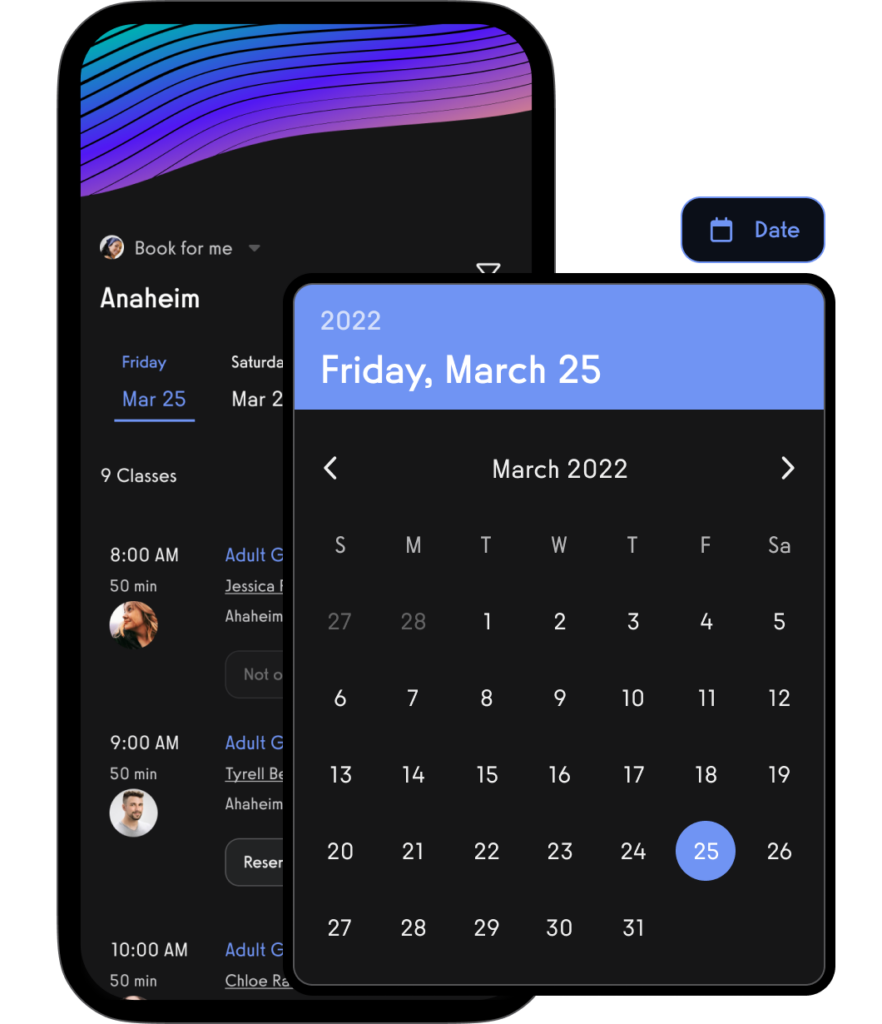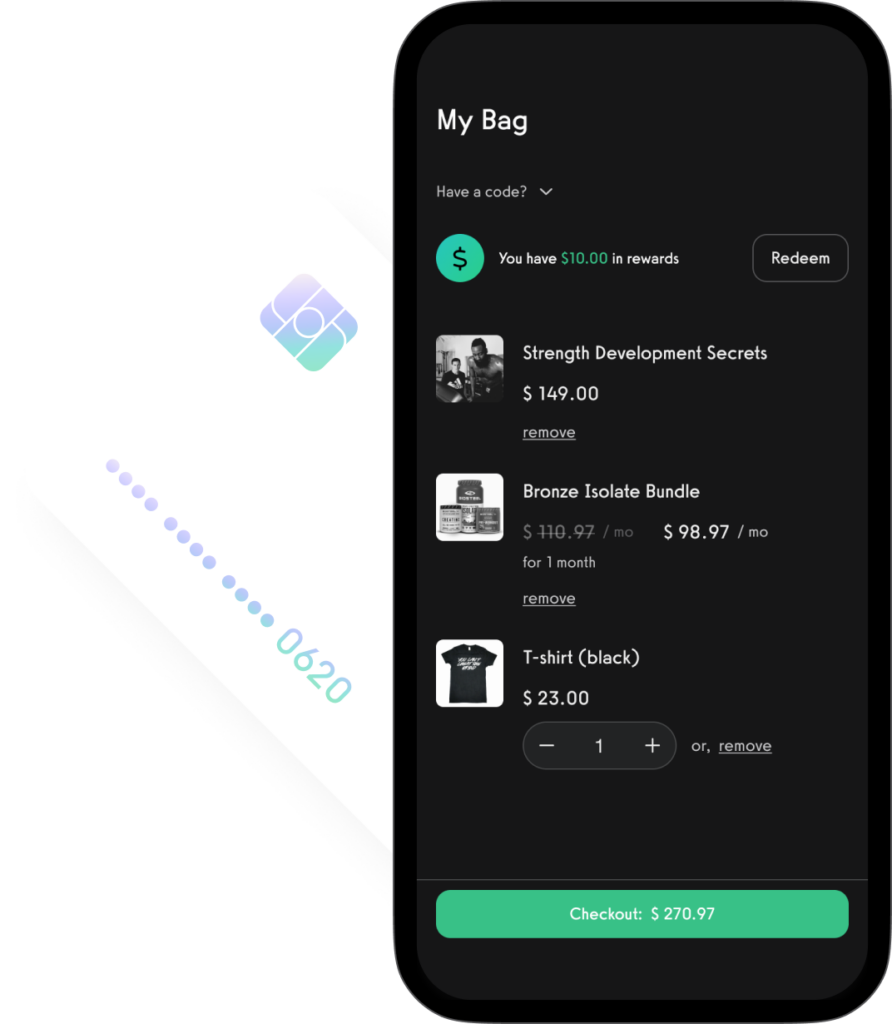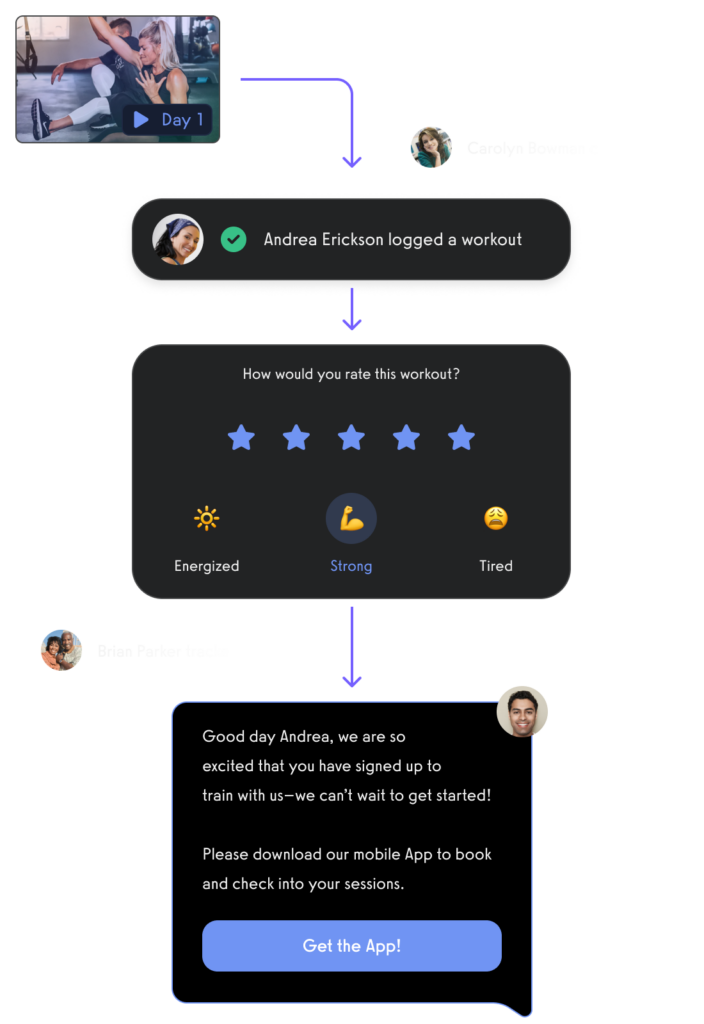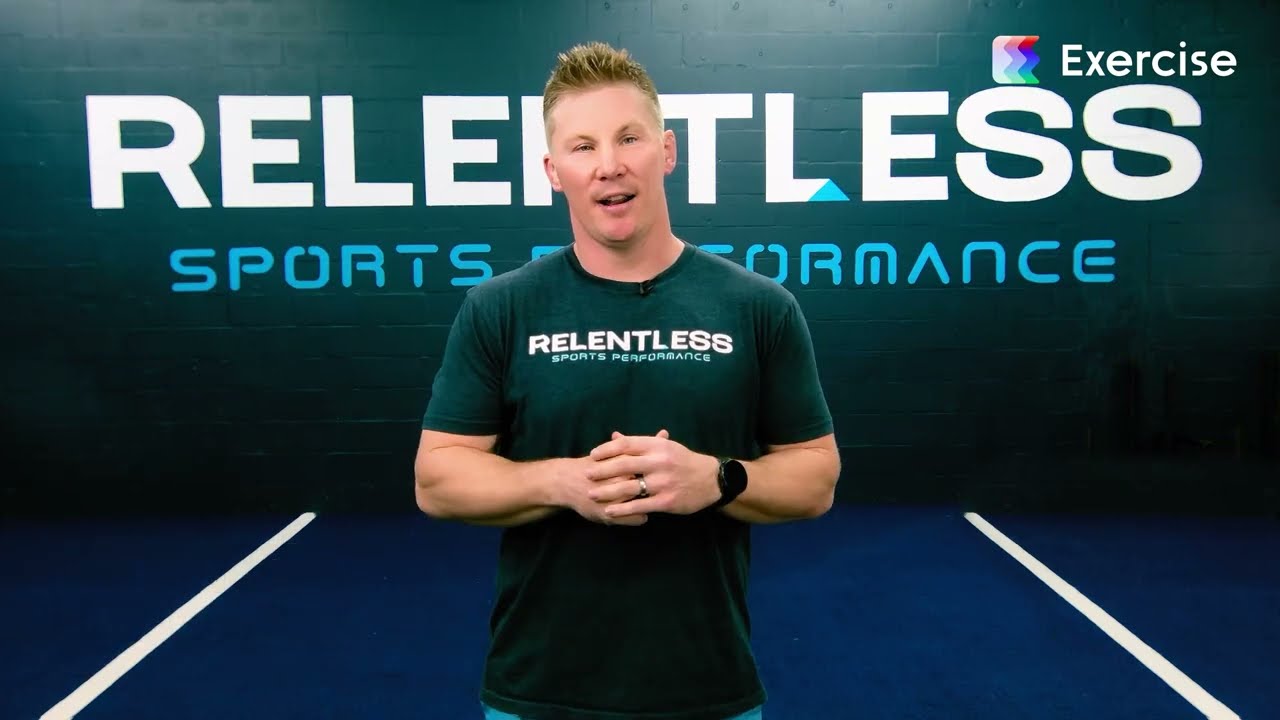Fitness Challenge Template (PDF, DOC, XLS – FREE)
Use this free fitness challenge template to learn how to run a fitness challenge and grow your fitness business.

Once you learn how to create a fitness challenge (the best fitness challenge software for gyms and fitness businesses makes everything super easy and seamless with your own custom branded fitness apps), then download the workout fitness challenge template in PDF, DOC, and XLS below.
Are you ready to transform your client’s fitness journey and take it to the next level while increasing your fitness business revenue? Then it’s time to embark on a fitness challenge! A fitness challenge can be a game-changer, providing your clients with the motivation, structure, and accountability you and your clients need to both achieve your client’s health and wellness goals, and for you to achieve your fitness business goals.
Looking for a fitness challenge template to kickstart your client’s fitness journey? This article provides a comprehensive guide on creating your own fitness challenge, including tips, templates, and strategies to help your clients achieve their fitness goals with fitness challenges. Be sure to also check out our big list of fitness challenge ideas for a gym, fitness challenge ideas for personal trainers, (and virtual fitness challenge ideas), learn how run an online fitness challenge, and how to automate and streamline the process with the best fitness challenge software for gyms, fitness influencers, personal trainers, and fitness coaches.
In this article, we’ll guide you through the process of modifying, creating, and implementing your very own fitness challenge template. From setting goals and choosing exercises to tracking progress and celebrating success, we’ll cover it all. So, let’s dive in and discover the incredible benefits of a fitness challenge!

And, of course, managing your fitness business online with the best gym management software and the best personal training software means that you can easily create fitness challenges, waivers, forms, fitness assessments, lead forms, registration forms, online booking, workout plans, and much more.
Create your fitness and workout challenges.

Offer booking and scheduling for your fitness challenges.

Create and sell fitness class packages as well as memberships, products, and digital offers.

Manage, message, and market to your leads and customers.

All from your very own custom branded fitness apps.


Free Fitness Challenge Template
A Fitness Challenge Template is a great way to engage members in a fun and motivational way, whether it’s for a gym, a personal trainer, or an online fitness community. Here’s a general template for creating a fitness challenge. If you’re looking for a complete solution to manage such challenges, including tracking progress, accepting payments, hosting exercise videos, and more, Exercise.com is a professional software tailored to the needs of fitness professionals. By booking a demo, you can explore how Exercise.com can help you run this and many other aspects of your fitness business through a custom branded app.
[Name of the Fitness Challenge]
Introduction:
Welcome to the [Name of the Fitness Challenge]! This exciting [Length of Challenge, e.g., 30-day] challenge is designed to [state the goals, e.g., help you lose weight, build strength, increase endurance, etc.]. Join us and take the first step toward a healthier you!
Start Date: [Start Date]
End Date: [End Date]
Challenge Details:
- Duration: [e.g., 30 days, 6 weeks, etc.]
- Categories: [e.g., Weight Loss, Muscle Gain, etc.]
- Levels: [e.g., Beginner, Intermediate, Advanced]
Requirements:
- [List any requirements for participation, e.g., gym membership, specific equipment, etc.]
Activities:
- Week 1: [Describe the activities, exercises, or tasks for the first week]
- Week 2: [Describe the activities for the second week]
- …
- Final Week: [Describe the activities for the final week]
Tracking Progress:
- [Explain how participants will track and report their progress, e.g., logbooks, mobile apps, etc.]
Rewards and Prizes:
- 1st Place: [Describe the prize for the first-place winner]
- 2nd Place: [Describe the prize for the second-place winner]
- …
- Participation Rewards: [If applicable, list any rewards for participation]
Registration:
- Registration Fee: [If applicable, state the fee and what it includes]
- Registration Deadline: [State the deadline for registration]
- How to Register: [Provide instructions on how to register, e.g., online form, in person, etc.]
Contact Information:
For any questions or additional information, please contact [Contact Name] at [Email Address] or [Phone Number].
Disclaimer:
[If necessary, include any disclaimers, such as reminding participants to consult with healthcare providers before beginning any new exercise program.]
Note: This Fitness Challenge Template can be customized to suit your specific goals, target audience, and challenge structure. If you are looking to professionally manage such challenges, along with other aspects of your fitness business like online booking, payment processing, and more, consider booking a demo with Exercise.com. The custom branded fitness app can provide a comprehensive solution tailored to your needs.
Read More:
- How to Run a Fitness Challenge
- How to Run a Fitness Challenge Online
- Best Fitness Challenge Software
- Fitness Challenge Ideas for a Gym
- Best Personal Trainer Challenge Ideas for Clients
- Virtual Fitness Challenge Ideas

Example 30-Day Fitness Challenge Template
Here is a structure for the Example Fitness Challenge Template. This template is designed to help gyms, personal trainers, or online fitness communities engage members through a fun and motivational challenge.
Challenge Title: 30-Day Fitness Challenge
Challenge Overview:
Welcome to the 30-Day Fitness Challenge! This challenge is designed to help you reach new fitness goals, increase motivation, and build a healthy routine. Each day, follow the set activities and record your progress to stay on track. By the end of the challenge, you’ll feel stronger, healthier, and more accomplished!
Challenge Details:
1. Duration:
30 days, starting from [Insert Start Date].
2. Goal:
Increase fitness levels through daily activities. Focus on strength, endurance, flexibility, or a mix, depending on your fitness goal.
3. Activities Schedule:
- Day 1-7: Cardio warm-up, bodyweight exercises, stretching
- Day 8-14: Cardio increase, weights or resistance exercises, core work
- Day 15-21: High-intensity interval training (HIIT), flexibility focus, optional rest day
- Day 22-30: Combo of all exercises, goal-setting for future routines
4. Daily Tracking:
Record the following each day:
- Activity Completed: (e.g., cardio, strength, flexibility)
- Duration: [Insert time]
- Intensity Level: Low, Medium, High
- Comments/Reflection: Describe how you felt, any improvements, or obstacles faced.
Challenge Rewards:
- Completion Prize: [Insert prize, e.g., gym merchandise, free personal training session]
- Milestone Rewards: Mini prizes for completing specific days (Day 10, 20, etc.)
- Recognition: Certificate of completion, social media shoutouts, or gym display board for participants.
Participant Agreement:
I, [Participant Name], commit to completing the activities in the 30-Day Fitness Challenge to the best of my ability. I understand this is a voluntary fitness program, and I am responsible for listening to my body and resting as needed.
Example Workplace Weight Loss Challenge Template
Here is a structure for the Workplace Weight Loss Challenge Template that’s designed to help fitness professionals, corporate wellness professionals, and employers engage employees in a friendly and motivational weight loss challenge.
Challenge Title: 6-Week Workplace Weight Loss Challenge
Challenge Overview:
Welcome to the 6-Week Workplace Weight Loss Challenge! This challenge aims to encourage employees to focus on healthy lifestyle habits and support each other’s fitness goals. Track your progress weekly and make use of wellness resources provided. Remember, this challenge is about building sustainable habits, not just the numbers on the scale!
Challenge Details:
1. Duration:
6 weeks, starting from [Insert Start Date].
2. Goal:
Encourage healthy weight loss and build positive health habits.
3. Activities Schedule:
- Week 1-2: Set baseline measurements, establish healthy eating, and moderate exercise
- Week 3-4: Increase activity level, incorporate strength training, add healthy snacks
- Week 5-6: Focus on endurance exercises, adjust meal plans, reflect on progress
4. Weekly Weigh-Ins:
Each participant will weigh in weekly on [Insert Day], and results will be recorded to track progress. Weigh-ins are confidential and intended to help participants monitor their progress.
5. Tracking Progress:
Participants will track:
- Weekly Weight
- Activity Level: e.g., hours of exercise per week
- Nutritional Adjustments: e.g., reduced sugar, more veggies
- Reflections: How are energy levels, mood, and general well-being?
Challenge Rewards:
- Grand Prize: Awarded to the participant who shows the most consistent progress
- Milestone Rewards: Small rewards for meeting weekly goals
- Recognition: Certificate of completion and recognition for healthy lifestyle achievements
Participant Agreement:
I, [Participant Name], commit to participating in the Workplace Weight Loss Challenge to the best of my ability. I agree to maintain confidentiality, respect, and positive support for fellow participants.
How do you structure a fitness challenge?
- Define the Goal: Determine the specific fitness goal for the challenge (e.g., weight loss, increased steps, building strength).
- Set the Duration: Decide the length of the challenge.
- Choose Activities: Outline the specific exercises, activities, or habits participants will engage in.
- Create Guidelines and Rules: Detail the rules and how progress will be tracked.
- Provide Resources: Offer workout plans, nutritional guidelines, etc.
- Implement Tracking and Support Systems: Use tracking sheets or apps, and provide regular support and motivation.
Read More: How to Run a Fitness Challenge
What makes a good fitness challenge?
A good fitness challenge is:
- Goal-Oriented: Clear and achievable goals.
- Engaging: Fun and motivating activities.
- Inclusive: Suitable for various fitness levels.
- Well-Supported: Ongoing support and encouragement.
- Measurable: Participants can track their progress.
How do I create a fitness challenge calendar template?
- Choose a Tool: Use a spreadsheet tool like Excel or Google Sheets.
- Outline the Challenge: Break down the challenge into daily or weekly tasks.
- Add Details: Include exercises, reps, sets, rest days, etc.
- Provide Guidance: Add links or tips for performing exercises correctly.
- Include Progress Tracking: Create a space for participants to record their results.
What is the best length of a fitness challenge?
The optimal length depends on the goals but typically ranges from 4 to 12 weeks. Shorter challenges (4-6 weeks) can be great for motivation, while longer ones (8-12 weeks) allow for more substantial progress.
How do you set up a step challenge?
- Define the Goal: Set a daily or total step count goal.
- Choose the Duration: Decide how long the challenge will last.
- Invite Participants: Encourage friends, family, or colleagues to join.
- Track Steps: Use pedometers, smartphones, or fitness trackers.
- Provide Motivation: Regular updates, encouragement, or rewards.
How to do a 6 week challenge?
A 6-week challenge could involve:
- Setting Specific Goals: Weight loss, muscle gain, etc.
- Creating a Plan: Detail workouts, nutrition, rest days.
- Tracking Progress: Regular check-ins, photos, or measurements.
- Providing Support: Regular encouragement, forums, or group chats.
How do you run a successful fitness challenge?
- Clear Goals and Guidelines: Outline what success looks like.
- Regular Communication: Send updates, reminders, and motivation.
- Provide Resources: Offer guides, tutorials, etc.
- Celebrate Success: Recognize and reward achievements.
How do you organize a wellness challenge at work?
- Identify the Focus: Could be fitness, nutrition, mental wellness, etc.
- Get Management Support: Ensure leadership is on board.
- Invite Participation: Encourage colleagues to join.
- Provide Resources and Support: Offer guidance, tracking tools, and encouragement.
- Celebrate Success: Acknowledge and reward participants.
How do you create a health challenge?
Follow the same basic structure as a fitness challenge, but include various aspects of health, such as nutrition, sleep, hydration, mental well-being, etc.
How do you start an activity challenge?
- Choose the Activity: Decide on the specific activity or set of activities.
- Set Rules and Guidelines: Outline the structure.
- Invite Participants: Friends, family, or community members.
- Provide Support: Regular updates, encouragement, and resources.
How can Exercise.com help me run a fitness challenge?
Exercise.com offers a robust platform tailored for fitness professionals to create, manage, and track fitness challenges. Through its custom-branded app, you can:
- Design Challenges: Easily create challenges with specific goals and parameters.
- Engage Participants: Provide resources, tracking tools, and communication within the app.
- Monitor Progress: See how participants are doing, send encouragement, and make adjustments as needed.
- Integrate Other Services: Manage other aspects of your business, like payments and bookings, within the same platform.
Exercise.com streamlines the process of running a fitness challenge, providing a professional and engaging experience for both organizers and participants. Booking a demo can help you understand how Exercise.com can be tailored to your specific needs, whether for fitness challenges or broader business management.












